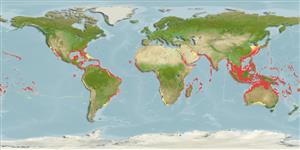Cephalopoda |
Oegopsida |
Onychoteuthidae
Environment: milieu / climate zone / Mức độ sâu / distribution range
Sinh thái học
Tầng nổi; Mức độ sâu 1 - 200 m (Tài liệu tham khảo 110525). Subtropical; 35°N - 36°S, 180°W - 180°E (Tài liệu tham khảo 97142)
Indo-Pacific, Atlantic Ocean and the Mediterranean. Tropical to subtropical.
Length at first maturity / Bộ gần gũi / Weight / Age
Chín muồi sinh dục: Lm ? range ? - ? cm Max length : 10.0 cm ML con đực/không giới tính; (Tài liệu tham khảo 97142)
Cosmopolitan circumglobal distribution, throughout tropical and subtropical/warm temperate oceans. Paralarvae and juveniles live near and at the surface, often in association with Sargassum sp. weed. Preyed upon by squid, Sthenoteuthis oualaniensis, and by yellowfin and bigeye tunas, and undoubtedly by many other epipelagic fishes and pelagic birds (Ref. 97142).
Life cycle and mating behavior
Chín muồi sinh dục | Sự tái sinh sản | Đẻ trứng | Eggs | Sự sinh sản | Larvae
Members of the class Cephalopoda are gonochoric. Male and female adults usually die shortly after spawning and brooding, respectively. Mating behavior: Males perform various displays to attract potential females for copulation. During copulation, male grasp the female and inserts the hectocotylus into the female's mantle cavity where fertilization usually occurs. Life cycle: Embryos hatch into planktonic stage and live for some time before they grow larger and take up a benthic existence as adults.
Turgeon, D.D., J.F. Quinn Jr., A.E. Bogan, E.V. Coan, F.G. Hochberg, W.G. Lyons, P.M. Mikkelsen, R.J. Neves, C.F.E. Roper, G. Rosenberg, B. Roth, A. Scheltema, F.G. Thompson, M. Vecchione and J.D. Willams 1998 Common and scientific names of aquatic invertebrates from the United States and Canada: Mollusks, 2nd ed. American Fisheries Society (Special publication 26), Bethesda, Maryland. 526 p. (Tài liệu tham khảo 1667)
IUCN Red List Status
(Tài liệu tham khảo 130435: Version 2025-1)
CITES status (Tài liệu tham khảo 108899)
Not Evaluated
CMS (Tài liệu tham khảo 116361)
Not Evaluated
Threat to humans
Human uses
| FishSource |
Các công cụ
Thêm thông tin
Population dynamicsSự sinh trưởngMax. ages / sizesLength-weight rel.Length-length rel.Length-frequenciesMass conversionSự phong phú Life cycleSự tái sinh sảnChín muồi sinh dụcSự sinh sảnĐẻ trứngEggsEgg developmentLarvae PhysiologyThành phần ô-xy
Human RelatedStamps, coins, misc.
Các nguồn internet
Estimates based on models
Fishing Vulnerability
Low vulnerability (10 of 100).
